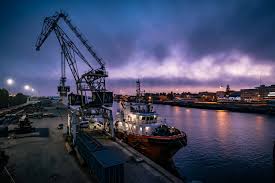
Industrial Transportation in India: Key Trends Shaping the Future
Introduction to Industrial Transportation in India
India is known for its vibrant economy and bustling industries, but a crucial component often flies under the radar: transportation. The movement of goods across this vast nation plays an integral role in shaping not just businesses but entire communities. As urbanization accelerates and consumer demands evolve, the need for efficient transport solutions has never been more pressing. From trucks navigating crowded city streets to rail networks linking remote areas, the landscape of industrial transportation in India is undergoing a significant transformation. With innovative technologies and supportive government policies paving the way, it's an exciting time for those involved in logistics. Let’s explore how these key trends are redefining the journey of goods — and what it means for every transporter in India today.
Growth Drivers in the Indian Transport Sector
The Indian transport sector is experiencing a remarkable transformation, fueled by several growth drivers. Rapid urbanization plays a vital role as cities expand and demand for efficient logistics increases.
Infrastructure development is another significant catalyst. The government’s investment in roads, railways, and ports enhances connectivity across the nation. This improvement facilitates smoother movement of goods and services.
Additionally, the rise of e-commerce has reshaped consumer expectations. Businesses now seek faster delivery systems to remain competitive. This shift demands innovative solutions from transporters in India to meet heightened customer demands.
Furthermore, foreign direct investment (FDI) policies have opened new avenues for international players. Enhanced partnerships bring advanced technologies and practices into the local market, driving efficiency.
An increasing focus on automation and digitalization revolutionizes operations within the industry. Smart logistics platforms help streamline processes and reduce costs significantly.
Technological Innovations Transforming Logistics
Technological innovations are revolutionizing logistics in India, making it more efficient and reliable. The adoption of advanced software solutions is streamlining supply chain management. Real-time tracking systems enhance visibility, allowing businesses to monitor their shipments closely.
Automation is another game-changer. Warehouses equipped with robotics reduce human error and speed up operations. Drones are also emerging as a viable option for last-mile delivery, especially in remote areas.
Artificial Intelligence plays a crucial role in optimizing routes and reducing transportation costs. Predictive analytics helps companies anticipate demand fluctuations, ensuring they remain responsive to market needs.
Blockchain technology enhances transparency across the supply chain by securely recording transactions. This fosters trust among stakeholders while minimizing fraud risks.
These technological advancements not only improve operational efficiency but also contribute significantly to customer satisfaction in the transport sector. The transformation is ongoing, shaping how goods move throughout India.
Impact of Government Policies on Transportation
Government policies play a pivotal role in shaping the transport sector in India. Initiatives like the Goods and Services Tax (GST) have streamlined logistics, reducing bottlenecks that hampered inter-state movement.
The National Logistics Policy aims to enhance connectivity and reduce logistics costs significantly. By prioritizing infrastructure development, it encourages private investment in transportation networks.
Additionally, subsidies for electric vehicles are pushing towards greener alternatives. This not only supports sustainability but also reduces reliance on fossil fuels.
Regulatory frameworks ensure safety standards and environmental compliance. These measures protect public interest while promoting efficient operations among transporters in India.
With ongoing reforms, government influence is evident at every level of logistics management. Stakeholders must stay informed about these changes to adapt swiftly and maintain competitiveness.
Challenges Facing Industrial Transport in India
India's industrial transport sector faces several challenges that hinder its growth. One significant issue is the inadequate infrastructure. Many roads, railways, and ports are outdated or poorly maintained. This leads to delays and increased transportation costs.
Regulatory hurdles also pose a problem for transporters in India. Complex taxation systems and varying state regulations can complicate logistics operations. Navigating these rules often requires additional time and resources.
Furthermore, traffic congestion remains a persistent challenge in urban areas. It affects delivery times and efficiency, causing frustration for both businesses and consumers alike.
Driver shortages create another layer of difficulty. As demand rises, finding skilled drivers becomes increasingly challenging, impacting service quality.
Safety concerns contribute to the challenges faced by this sector. Accidents on highways not only threaten lives but also disrupt supply chains significantly. Addressing these issues will be crucial for future progress in India's industrial transportation landscape.
Sustainability and Green Initiatives in Logistics
Sustainability is at the forefront of industrial logistics in India. As environmental concerns grow, the industry is responding with innovative green initiatives.
Transporters are increasingly adopting alternative fuels like biofuels and electric vehicles. These changes not only reduce carbon emissions but also enhance operational efficiency.
Moreover, companies are investing in smart technology to optimize routes. This reduces fuel consumption and minimizes traffic congestion, leading to a smaller carbon footprint.
Warehouse management systems are evolving too. More facilities now utilize energy-efficient lighting and renewable energy sources, such as solar power.
Collaboration among stakeholders is crucial for these efforts to succeed. Industry players are engaging more with local communities to promote sustainable practices throughout their supply chains.
Emphasizing recycling and waste reduction measures has become common practice as well, showcasing a commitment to preserving resources while meeting consumer demands.
Future Outlook for Indian Transport
The future of industrial transportation in India appears promising and dynamic. As urbanization continues to rise, the demand for efficient logistics solutions will only intensify. Transporters in India are gearing up to meet these challenges with innovative approaches.
Smart technology integration is likely to play a pivotal role. From AI-driven route optimization to real-time tracking systems, advancements will enhance efficiency and reduce operational costs.
Electric vehicles (EVs) are also set to make significant strides. With government incentives promoting green initiatives, many transporters are exploring sustainable alternatives that align with global environmental goals.
Moreover, infrastructure improvements will reshape logistics networks across the country. Investments in roads, railways, and ports aim at creating seamless connectivity between regions.
As e-commerce flourishes, last-mile delivery solutions will evolve rapidly. Adapting quickly to consumer demands could define the next era of transportation in India.